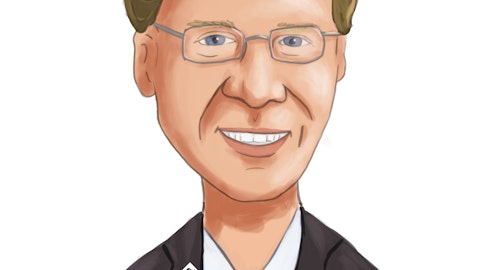De Lyle Bloomquist: Hi, Paul, this is De Lyle. With respect to fluff pricing, again, we’re assuming that they’re going to follow generally with the indices that are out there on fluff, but what we’re noticing is that it’s going down slower than expected. And in fact we’ve seen a couple of our competitors actually announced some recent price increases. So we think we may actually be troughing out here relatively soon. Viscose pricing, similar situation, just as recently as the, a couple of days ago there was a slight uptick in the pricing for softwood going into the viscose market. Again, what we’re forecasting is per the indices, but we’re seeing that because of the increase in capacity utilization in China that, again, that there may be some upside potential with respect to viscose pricing. But right now, the forecast and the guidance we’ve given is essentially based on the indices that have been published.
Paul Quinn: Okay. And then you guys mentioned higher corporate costs in 2023 here. That was $45 million in 2022 or we talking to in the $50 million to $55 million range?
De Lyle Bloomquist: Yes, that’s correct, Paul. That’s about the right range. Again, the increase in spending is tied to the ERP implementation and the fact that we don’t think €“ right now, we’re not forecasting raising in FX benefit this year.
Paul Quinn: Okay. And then just earlier this year, you attempted to re-buy the senior un-secureds and didn’t conclude that deal. Can you give us a little bit more color on that process and the timing of when you expect that to try that again?
De Lyle Bloomquist: Well, in January, we just see it turned out that the market conditions just weren’t conducive for us. I get a deal that we felt was one indicative of what we consider to be a fairly strong business. So looking forward, we think actually time is on our side and that we think our financial metrics will improve with time, and so we’re patient. And we want to get past at least Q1 earnings because again, we think that will confirm the guidance we just gave you. And with that, we think we’ll be looking at that point to look at the markets and possibly enter at that point.
Paul Quinn: Okay. And then just lastly, just back on debottlenecking project, you’ve got adjusted to get more volume, I guess, on the fluff line. What’s the volume increase do you think you’re going to get through that process? And what’s involved?
De Lyle Bloomquist: Yes. That’s a great question. I’m not an engineer, so I can’t really get into the specifics about what we did. But at the end of the day, I believe the increase is 40,000 to 50,000 tons additional capacity that we get from that investment. And it really came down to essentially putting in additional dryer cans to allow us to speed up the line while allowing it for enough drying capacity to get the right specifications on the product. So — and then on the finishing side, when you obviously speed up the capability of the line, you’ve got to also increase the capability of our ability to package it appropriately for our competitors — for our customers. And so we’ve put some investment also in the finishing line as well.
Paul Quinn: All right. thanks very much. That’s all I had. Good luck.
Operator: Our next question is a follow-up from the line of Roger Spitz with Bank of America. Please proceed with your question.
Roger Spitz: Thank you very much. A few others. So can you talk any more guidance on the High-Yield Pulp segment in 2023, does that reverse back to the last few years kind of level? How should we think about that?
De Lyle Bloomquist: That’s a great question, Roger. It’s obviously — it’s — we’re seeing pricing decline right now, but we’re going to see some offset on that — on the volumes in 2023, given the increased productivity that we’re expecting after the investments we made last year. So in terms of overall EBITDA for high purity, we’re expecting it — I’m looking at some numbers. I’m seeing, if I can find the actual number for you here. It’s going to be about the same, as we experienced in 2022 versus 2023, even though we see lower pricing, but it should be offset by the increased productivity and the increased sales volumes later this year.





